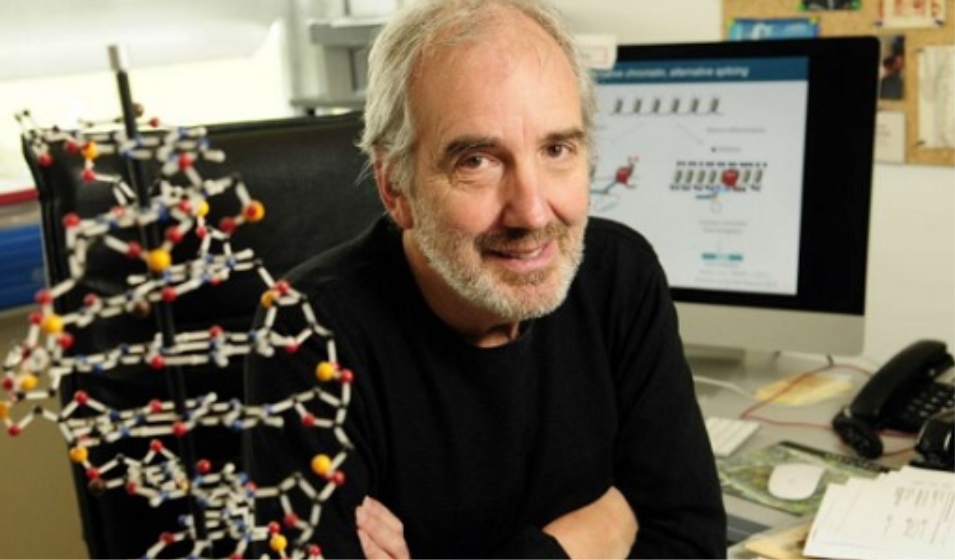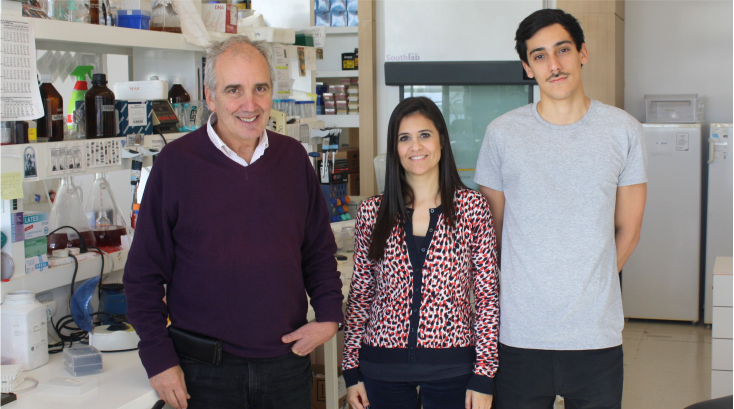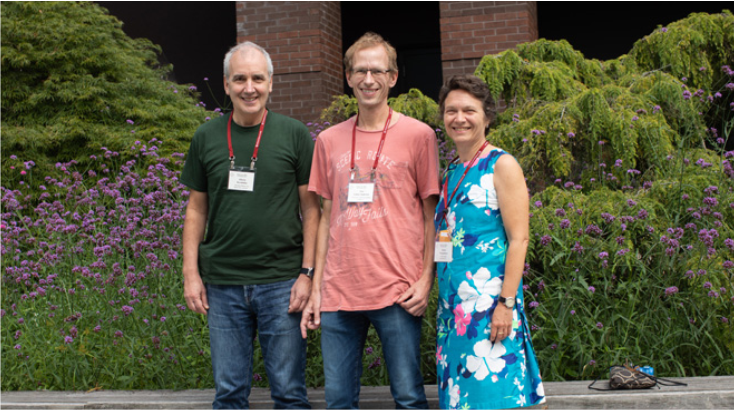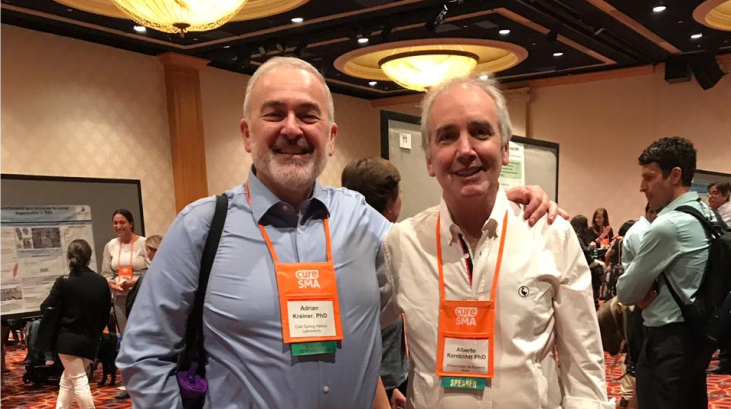
Regulación del "splicing" alternativo del RNA mensajero
Dr. Alberto Kornblihtt
JEFE DE GRUPO
Profesor Titular Plenario, FCEN, UBA.
Investigador Superior (CONICET)
Nuestro laboratorio trabaja en la regulación del splicing alternativo del precursor del RNA mensajero, explicando cómo un único gen es capaz de generar muchas proteínas. Encontramos que cambios en la velocidad de elongación de la transcripción controlan el splicing alternativo. También desciframos cómo el daño del DNA por luz ultravioleta y cambios epigenéticos en la cromatina modulan al splicing alternativo a través de su acoplamiento con la transcripcion.
Lineas de investigacion:
El splicing alternativo contribuye a generar una gran diversidad proteica a partir de un número limitado de genes. Hallazgos recientes justifican un renovado interés en este proceso, el cual se estima que afecta más del 95% de los genes humanos. Por consiguiente, el splicing alternativo es más una regla que una excepción entre los mecanismos de expresión genética de nuestras células. Mutaciones que afectan a secuencias reguladoras del splicing alternativo son una fuente muy amplia de enfermedades humanas. En efecto, muchas enfermedades hereditarias y cánceres son causados por mutaciones que alteran la función de secuencias reguladoras del splicing alternativo. Además, este mecanismo es particularmente importante en el desarrollo del sistema nervioso. La regulación del splicing alternativo no sólo depende de la interacción de factores de splicing con sus secuencias “blanco” en el precursor del RNA mensajero (premRNA), sino también, como le ocurre a otras reacciones de procesamiento del pre-mRNA, está acoplada a la transcripción por la RNA polimerasa II.
La investigación del grupo está focalizada en la regulación del splicing alternativo, con un énfasis particular en los mecanismos que acoplan las maquinarias de transcripción y de splicing. El grupo estudia cómo cambios en la velocidad de elongación transcripcional y de la estructura de la cromatina contribuyen a la generación de múltiples variantes de proteínas a partir de un único gen, tanto en células humanas como en plantas.
El contexto cromatínico afecta la tasa de elongación de Pol II, lo que a su vez modifica el splicing alternativo. Nuestros trabajos confirman un modelo en que modificaciones post-traduccionales de histonas que contribuyen a una compactación de la cromatina, tal como la dimetilación de la lisina 9 de la histona H3 (H3K9me2) inhiben la elongación de la transcripción y, por lo tanto, tienen efectos sobre ciertos eventos de splicing alternativo que son opuestos a los causados por acetilación de la misma histona (H3K9Ac).
Encontramos que RNAs pequeños de interferencia (small interfering RNAs, siRNAs) dirigidos contra el intrón río abajo de un exón alternativo afectan el splicing alternativo a través de un mecanismo conocido como silenciamiento génico transcripcional (transcriptional gene silencing, o TGS). Los siRNAs intrónicos gatillan la heterocromatinización en los sitios blanco en el DNA por medio de la dimetilación de la lisina 9 de la histona H3 (H3K9me) y consecuente inhibición de la elongación transcripcional, que a su vez afecta el splicing alternativo. El efecto de los siRNAs intrónicos sobre el splicing alternativo no está relacionado con el silenciamiento génico post-transcripcional. Encontramos que la proteína argonauta AGO1 es necesaria para obtener este efecto sobre la estructura cromatínica. Estamos llevando a cabo un estudio sistemático para identificar en el genoma humano sitios blanco de AGO1 con un rol en el control del splicing alternativo por siRNAs.
Usamos la planta modelo Arabidopsis thaliana para investigar el mecanismo por el cual las condiciones de luz/oscuridad afectan el splicing alternativo. Encontramos que el cloroplasto responde a la luz generando una señal retrógrada que actúa en el núcleo en la regulación del splicing alternativo de determinados genes. La señal es gatillada por la plastoquinona (PQ) en su estado reducido La PQ es uno de los eslabones del transporte electrónico fotosintético. Más recientemente, encontramos que la señal que sale del cloroplasto cuando la planta es expuesta a la luz aumenta la velocidad de elongación de la enzima RNA polimerasa. En otros palabras, descubrimos que en en las plantas, la elongación de la transcripción es más rápida de día que de noche, lo cual explica el mecanismo nuclear del control del splicing alternativo por la luz.
La atrofia muscular espinal (AME) es un trastorno genético de las neuronas motoras que es la principal causa genética de mortalidad infantil y es causada pormutaciones del gen SMN1. En individuos sanos, SMN1 codifica la proteína survival of motor neuron (SMN), que desempeña un papel crucial en el sistema nervioso. Los humanos tenemos un parálogo de SMN1, llamado SMN2. Debido a diferencias de secuencia, el exón 7 de SMN2 (E7) es poco incluido en su ARNm lo que hace que solo el 10-20% de los transcriptos de SMN2 codifiquen la proteína de longitud completa. Por lo tanto, en ausencia de expresión de SMN1, SMN2 no puede compensar la deficiencia en la proteína SMN. El Dr. A. Krainer (CSHL, Nueva York) desarrolló una terapia para AME y la FDA la aprobó en diciembre de 2016. Krainer diseñó un poderoso oligonucleótido específico de alelo (ASO), llamado Spinraza, que promueve la inclusión de E7 en el transcripto de SMN2, en células, animales y pacientes. Spinraza interactúa con una secuencia localizada en el intrón que sigue a E7 (intrón 7), que es el sitio de unión de los factores de splicing negativos hnRNPA1 y A2. Cuando el sitio de unión hnRNPA1 / A2 es bloqueado por el ASO, la inclusión de E7 en el ARNm aumenta y se producen niveles más altos de proteína SMN de longitud completa. Hemos encontrado en células humana en cultivo, que la elongación transcripcional rápida, causada por la relajación de la cromatina debida a la acetilación de histonas, promueve la inclusión de SMN2 E7 y que el uso combinado del inhibidor de la histona deacetilasa (HDAC) y Spinraza regulan de forma sinérgica la inclusión de E7. También observamos que la administración combinada de ASO similar a Spinraza y TSA tiene fuertes efectos sinérgicos sobre el crecimiento y la supervivencia de los ratones con AME. Estos trabajos apuntan a establecer una terapia combinada entre Spinraza e inhibidores de histona deacetilasas en pacientes con AME.
Los avances obtenidos fueron posibles gracias al apoyo de Familias Atrofia Muscular Espinal Argentina (FAME) y CureSMA de EEUU.
Biología molecular básica (clonado, marcado, hibridación, electroforesis en geles de agarosa y de poliacrilamida, PCR, RT-PCR, PCR en tiempo real) / – Cultivo de células de mamíferos / – Transfecciones de células con DNA y con RNA / – Interferencia por RNA / – Inmunoprecipitación de la cromatina (ChIP) / – Ensayo de accesibilidad de cromatina por MspI / – ChIP-seq / – Western blotting / – Inmunofluorescencia / – Ensayo de protección a la Rnasa (RPA) / – Ensayo de Run-on / – Expresión de genes usando RNA polimerasas mutantes resistentes a alfa-amanitina / – Manipulaciones básicas de Arabidopsis
-

Nuevos avances en el tratamiento para la enfermedad de atrofia muscular espinal
-

-

-
Seleccionadas de un total de 135. Para un listado completo ver este link de PubMed: https://www.ncbi.nlm.nih.gov/pubmed/?term=kornblihtt+a
Ordenadas de más viejas a más recientes
– Kornblihtt, A. R., Flawiá, M. M., & Torres, H. N. Manganese ion dependent adenylate cyclase activity in rat testes: purification and properties. Biochemistry 20, 1262-1267 (1981).
– Reig, J. A., Kornblihtt, A. R., Flawiá, M. M. & Torres, H. N. Soluble adenylate cyclase activity in Neurospora crassa. Biochem. J. 207, 43-49 (1982)
– Flawiá, M. M., Kornblihtt, A. R., Reig, J. A., Torruella, M. & Torres, H. N. Reconstitution of a hormone-sensitive adenylate cyclase with membrane extracts from Neurospora and avian erythrocytes. J. Biol.Chem. 258, 8355-8259 (1983).
– Shoulders, C. C., Kornblihtt, A. R., Munro, B. S. & Baralle, F. E. Gene structure of human apolipoprotein A1. Nucleic Acids Res. 11, 2827-2837 (1983).
– Kornblihtt, A. R., Vibe-Pedersen, K. & Baralle, F. E. Isolation and characterization of cDNA clones for human and bovine fibronectins. Proc. Natl. Acad.Sci.USA 80, 3218-3222 (1983).
– Kornblihtt, A. R., Vibe-Pedersen, K. & Baralle, F. E. Human fibronectin: molecular cloning evidence for two mRNA species differing by an internal segment coding for a structural domain. EMBO J. 3, 221-226 (1984).
– Kornblihtt, A. R., Vibe-Pedersen, K. & Baralle, F. E. Human fibronectin: cell-specific alternative splicing generates polypeptide chains differing in the number of internal repeats. Nucleic Acids Res. 12, 5853-5868 (1984).
– Vibe-Pedersen, K., Kornblihtt, A. R. & Baralle, F. E. Expression of a human alpha globin/fibronectin gene hybrid generates two mRNAs by alternative splicing. EMBO J. 3, 2511-2516 (1984).
– Umezawa, K., Kornblihtt, A. R. & Baralle, F. E. Isolation and characterization of cDNA clones for human liver fibronectin. FEBS Lett. 186, 31-34 (1985).
– Kornblihtt, A. R., Umezawa, K., Vibe-Pedersen, K. & Baralle, F. E. Primary structure of human fibronectin: differential splicing may generate at least 10 polypeptides from a single gene. EMBO J. 4, 1755-1759 (1985).
– Gutman, A., Yamada, K. & Kornblihtt, A. R. Human fibronectin is synthesized as a pre-propolypeptide. FEBS Lett. 207, 145-148 (1986).
– Colombi, M., Barlati, S., Kornblihtt, A. R., Baralle, F. E. & Vaheri, A. A family of fibronectin mRNAs in human normal and transformed cells. Biochim. Biophys.Acta 868, 207-214 (1986).
– Gutman, A. & Kornblihtt, A. R. Identification of a third region of cell-specific alternative splicing in human fibronectin mRNA. Proc. Natl. Acad.Sci.USA 84, 7179-7182 (1987).
– Obara, M., Kang, M. S., Rocher-Dufour, S., Kornblihtt, A. R., Thiery, J.P. & Yamada, K. M. Expression of the cell binding domain of human fibronectin in E. coli: identification of sequences promoting full to minimal adhesive function. FEBS Lett. 213, 261-264 (1987).
– Dufour, S., Duband, J. L., Kornblihtt, A. R. & Thiery, J. P. Role of fibronectins during embryonic development and cell migrations. Trends in Genetics 4, 198-203 (1988).
– Seebacher, T., Manske, M., Kornblihtt, A. R. & Bade, E. G. Cellular fibronectin is induced by epidermal growth factor, but not by dexametasone or cyclic AMP in rat liver epithelial cells. FEBS Lett. 239, 113-116 (1988).
– Kornblihtt, A. R. & Gutman, A. Molecular Biology of the Extracellular Matrix Proteins. Biological Reviews 63, 465-507 (1988).
– Bernath, V. A., Muro, A. F., Vitullo, A. D., Bley, M. A., Barañao, J. L. & Kornblihtt, A. R. Cyclic AMP inhibits fibronectin gene expression in a newly developed granulosa cell line by a mechanism that suppresses cAMP-responsive-element transcriptional activation. J. Biol. Chem. 265, 18219-18226 (1990).
– Dufour, S., Gutman, A., Bois, F., Lamb, N., Thiery, J. P. & Kornblihtt, A. R. Generation of full-length cDNA recombinant vectors for the expression of fibronectin in mammalian cell lines. Exp. Cell Res. 193, 331-338 (1991).
– Muro, A. F., Puricelli, L., Kornblihtt, A. R. & Bal de Kier Joffé, E. Inverse correlation between fibronectin mRNA levels and the metastatic potential of two murine mammary adenocarcinomas. Invasion Metastasis 11, 281-287 (1991).
– Muro, A. F., Bernath, V. A. & Kornblihtt, A. R. Interaction of the -170 Cyclic AMP response element with the adjacent CCAAT box in the human fibronectin gene promoter. J. Biol. Chem. 267, 12767-12774 (1992).
– Srebrow, A., Muro, A. F., Werbajh, S. & Kornblihtt, A. R. The CRE-binding factor ATF-2 facilitates the occupation of the CCAAT box in the fibronectin gene promoter. FEBS Lett. 327, 25-28 (1993).
– Rossi, M. S., Pesce, C. G., Reig, O. A., Kornblihtt, A. R. & Zorzópulos, J. Retroviral-like features in the monomer of the major satellite DNA from the South American rodents of the genus Ctenomys. DNA Seq. 3, 379-382 (1993).
– Muro, A. F., Pesce, C. G. & Kornblihtt, A. R. DNA sequencing by the chemical method: a 10 minute procedure for the G + A reaction. Trends in Genetics 9, 337-338 (1993).
– Lavigueur, A., La Branche, H., Kornblihtt, A. R. & Chabot, B. A splicing enhancer in the human fibronectin alternate ED1 exon stimulates the binding of U2AF65 and U2 snRNP. Genes & Dev. 7, 2405-2417 (1993).
– Pesce, C. G., Rossi, M. S., Muro, A. F., Zorzópulos, J. & Kornblihtt, A. R. Binding of nuclear factors to a satellite DNA of retroviral origin with marked differences in copy number among species of the rodent Ctenomys. Nucleic Acids Res. 22, 656-661 (1994).
– Guerra, F., Eijan, A. M., Puricelli, L., Alonso, D. E., Bal de Kier Joffé, E., Kornblihtt, A. R., Charreau, E. H. & Elizalde, P. V. Varying patterns of expression of insulin-like growth factors I and II and their receptors in murine mammary adenocarcinomas of different metastasizing ability. Int. J. Cancer 65, 812-820 (1996).
– Alonso, C. R., Pesce, C. G. & Kornblihtt, A. R. The CCAAT-binding proteins CP1 and NF-I cooperate with ATF-2 in the transcription of the fibronectin gene. J. Biol. Chem. 271, 22271-22279 (1996).
– Kornblihtt, A. R., Alonso, C. R., Cramer, P., Pesce, C. G., Srebrow, A., Werbajh, S. E. & Muro, A. F. The fibronectin gene as a model for transcription and splicing studies. FASEB J. 10, 248-257 (1996).
– Iglesias, D. M., Martin, R. S., Fraga, A., Virginillo, M., Kornblihtt, A. R., Arrizurieta, E., Viribay, M., San Millán, J. L., Herrera, M. y Bernath, V. A. Genetic heterogeneity of autosomal polycystic kidney disease in Argentina. J. Med. Genet., 34 , 827-830 (1997).
– Cramer, P., Pesce, C. G., Baralle, F. E. & Kornblihtt, A. R. Functional association between promoter architecture and transcript alternative splicing. Proc. Natl. Acad. Sci. USA 94,, 11456-11460 (1997).
– Gómez, E., Kornblihtt, A. R. & Téllez-Iñón, M. T. Cloning of a functional cdc2-related protein kinase (CRK) from Trypanosoma cruzi that interacts with mammalian cyclins. Mol. Biochem. Parasitol. 91 , 337-351 (1998).
– Urtreger, A., Porro F., Puricelli, L., Werbajh, S., Baralle, F. E., Bal de Kier Joffe, E., Kornblihtt, A. R. & Muro, A. F. Expression of RGD minus fibronectin that does not form extracellular matrix fibrils is sufficient to decrease tumor metastasis. Int. J. Cancer 78, 233-241 (1998).
– Werbajh, S. E., Urtreger, A. J., Puricelli, L., S. de Lustig, E., Bal de Kier Joffé, E. & Kornblihtt, A. R. Downregulation of fibronectin transcription in highly metastatic adenocarcinoma cells. FEBS Lett. 440, 277-281 (1998).
– Colman-Lerner, A., Fischman, M. L., Lanuza, G. M., Bissell, D. M., Kornblihtt, A. R. & Barañao, J. L. Evidence for a role of the alternatively spliced ED-I sequence of fibronectin during ovarian follicular development. Endocrinology 140, 2541-2548 (1999).
– Melen, G. J., Pesce, C. G., Rossi, M. S. & Kornblihtt, A. R. Novel processing in a mammalian nuclear 28S pre-rRNA: tissue-specific elimination of an “intron” bearing a hidden break site. EMBO J. 18, 3107-3118 (1999).
– Cramer, P., Cáceres, J., Cazalla, D., Kadener, S., Muro, A. F., Baralle, F. E. & Kornblihtt, A. R. Coupling of transcription with alternative splicing: RNA pol II promoters modulate SF2/ASF and 9G8 effects on an exonic splicing enhancer. Molecular Cell 4, 251-258 (1999).
– Pesce, C. G., Nogués, G., Alonso, C. R., Baralle, F. E. & Kornblihtt, A. R. Interaction between the -170 CRE and the -150 CCAAT box is necessary for efficient activation of the fibronectin gene promoter by cAMP and ATF-2. FEBS Lett. 457, 445-451 (1999).
– Diaz Añel, A. M., Rossi, M. S., Espinosa, J. M., Guida, C., Freitas, F. A., Kornblihtt, A. R., Zingales, B., Flawia, M. M. & Torres, H. N.”mRNA encoding a putative RNA helicase of the DEAD box gene family is up-regulated in trypomastigotes of Trypanosoma cruzi”. J. Eukaryotic Microbiol. 47, 555-560 (2000).
– Kadener, S., Cramer, P., Nogués, G., Cazalla, D., de la Mata, M., Fededa, J. P., Werbajh, S., Srebrow, A. & Kornblihtt, A. R. Antagonistic effects of T-Ag and VP16 reveal a role for RNA pol II elongation on alternative splicing. EMBO J. 20, 5759-5768 (2001).
– Cramer, P., Srebrow, A., Kadener, S., Werbajh, S., de la Mata, M., Melen, G. Nogués, G. & Kornblihtt, A. R. Coordination between transcription and pre- mRNA processing. FEBS Lett. 498, 179-182 (2001).
– Srebrow, A., Blaustein, M. & Kornblihtt, A. R. Regulation of fibronectin alternative splicing by a basement membrane-like extracellular matrix. FEBS Lett. 514, 285-289 (2002).
– Cáceres, J. F. & Kornblihtt, A. R. Alternative splicing regulation: multiple control mechanisms and involvement in human disease. Trends Genet. 18, 186-193 (2002).
– Kadener, S., Fededa, J. P., Rosbash, M. & Kornblihtt, A. R. Regulation of alternative splicing by a transcriptional enhancer through RNA pol II elongation. Proc. Natl. Acad. Sci. USA 99, 8185-8190 (2002). Selected as “must read” (factor 3) in Faculty of 1000.
– Alonso, C. R., George, J., Pesce, C. G., Bissell D. M. & Kornblihtt, A. R. Fibronectin transcription in liver cells: promoter occupation and function in sinusoidal endothelial cells and hepatocytes. Biochem. Biophys. Res. Commun. 295, 1077-1084 (2002).
– Nogués, G., Kadener, S., Cramer, P., Bentley, D. & Kornblihtt, A. R. Transcriptional activators differ in their abilities to control alternative splicing. J. Biol. Chem. 277, 43110-43114 (2002).
– Pagani, F., Stuani, C., Kornblihtt, A. R. & Baralle, F. E. Promoter architecture modulates CFTR exon 9 skipping. J. Biol. Chem. 278, 1511-1517 (2003).
– Labriola, L., Salatino, M., Proietti, C., Pecci, A., Coso, O. A., Kornblihtt, A. R., Charreau, E. H. & Elizalde, P. Heregulin induces transcriptional activation of the progesterone receptor by a mechanism that requires a functional ErbB-2 and MAPK activation in breast cancer cells. Mol. Cell. Biol. 23, 1095-1111 (2003).
– Portal, D., Espinosa, J., Lobo, G., Kadener, S., Pereira, C., de la Mata, M., Ren-Jan Lin, Tang, Z., Kornblihtt, A., Gómez, E., Baralle, F., Flawiá, M.M. & Torres, H. N. An early ancestor in the evolution of splicing: A Trypanosoma cruzi serine-arginine-rich protein (TcSR) is functional in cis-splicing. Mol. Biochem. Parasitol 127, 37-46 (2003).
– Portal, D., Lobo, G., Kadener, S., Prasad, J., Espinosa, J., Pereira, C., Lin, Z., Manley, J., Kornblihtt, A., Flawiá, M.M. & Torres, H.N. Trypanosma cruzi TcSRPK, the first protozoan member of the SRPK family, is biochemically and functionally conserved with metazoan SR protein-specific kinases. Mol. Biochem. Parasitol. 127, 9-21 (2003).
– de la Mata, M., Alonso, C. R., Kadener, S., Fededa, J. P., Blaustein, M., Pelisch, F., Cramer, P., Bentley, D., & Kornblihtt, A. R. A slow RNA polymerase II affects alternative splicing in vivo. Molecular Cell 12, 525-532 (2003). Commented as News and Views in Nature Struct. Mol. Biol. 10, 876-878 (2003). Selected as “exceptional” (factor 9) in Faculty of 1000.
– Nogués, G., Muñoz, M. J. & Kornblihtt, A. R. Influence of pol II processivity on alternative splicing depends on splice site strength. J. Biol. Chem. 278, 52166-52171 (2003).
– Nogués, G., Kadener, S., Cramer, P., de la Mata, M., Fededa, J. P., Blaustein, M., Srebrow A. & Kornblihtt, A. R. Control of alternative pre-mRNA splicing by RNA Pol II elongation: faster is not always better. IUBMB Life 55, 235-241 (2003).
– Kornblihtt, A. R., de la Mata, M., Fededa, J. P., Muñoz, M. J. & Nogués, G. Multiple links between transcription and splicing. RNA 10, 1489-1498 (2004).
– Blaustein, M., Pelisch, F., Coso, O., Bissell, M., Kornblihtt, A. R. & Srebrow, A. Mammary epithelial-mesenchymal interaction regulates fibronectin alternative splicing via PI3K-dependent pathway. J. Biol. Chem. 279, 21029 – 21037 (2004).
– Chang, M-L., Chen, J-C., Alonso,C. R., Kornblihtt, A. R. & Bissell, D. M. Regulation of fibronectin splicing in sinusoidal endothelial cells from normal or injured liver. Proc. Natl. Acad. Sci. USA 101, 18093-18098 (2004).
– Kornblihtt, A. R. Shortcuts to the end. Nature Struct. Mol. Biol. 11, 1156-1157 (2004). (News and Views article).
– Kornblihtt, A. R. Promoter usage and alternative splicing. Curr. Op. Cell Biol17, 262-268 (2005).
– Proietti, C., Salatino, M., Rosemblit, C., Carnevale, R., Pecci, A., Kornblihtt, A. R., Molinolo, E., Frahm, I., Charreau, E. H., Schillaci, R. & Elizalde, P. Progestins Induce Transcriptional Activation of Signal Transducer and Activator of Transcription 3 (Stat3) Via Jak and Src-Dependent Mechanism in Breast Cancer Cells. Mol. Cell. Biol. 25, 4826–4840 (2005).
– Pelisch, F., Blaustein, M., Kornblihtt, A. R. & Srebrow. A. Cross-talk between signaling pathways regulates alternative splicing: a novel role for JNK. J. Biol. Chem. 280, 25461-25469 (2005).
– Fededa, J. P., Petrillo, E., Gelfand, M. S., Neverov, A. D., Kadener, S., Nogués, G., Pelisch, F., Baralle, F. E., Muro, A. F., and Kornblihtt, A. R. A polar mechanism coordinates different regions of alternative splicing within a single gene. Molecular Cell. 19, 393-404 (2005).
– Blaustein, M., Pelisch, F., Tanos, T., Muñoz, M., Sanford, J. R., Wengier, D., Quadrana, L., Sanford, J., Muschietti, J. P., Kornblihtt, A. R., Cáceres, J., Coso, O. A. & Srebrow, A. Concerted regulation of nuclear and cytoplasmic activities of SR proteins by AKT Nature Struct. Mol. Biol. 12, 1037-1044 (2005). Commmented as News and Views in Nature Struct. Mol. Biol. 12, 1022-1023 (2005). Selected in Faculty of 1000.
– de la Mata, M. & Kornblihtt, A. R. RNA polymerase II C-terminal domain mediates regulation of alternative splicing by SRp20. Nature Struct. Mol. Biol. 13, 973-980 (2006). Commented as News and Views in Nature Struct. Mol. Biol. 13, 952-953, 2006. Selected in Faculty of 1000. Cover of the issue.
– Kornblihtt, A. R. Chromatin, transcript elongation and alternative splicing. Nature Struct. Mol. Biol. 13, 5-7 (2006) (News and Views article).
– Srebrow, A. & Kornblihtt, A. R. The splicing and cancer connection. J. Cell. Sci. 119, 2635-2641 (2006).
– Kornblihtt, A. R. On intelligent design, cognitive relativism, vitalism and the mystery of the real world. IUBMB Life 59, 235-237 (2007).
– Cáceres, J. F., Krainer, A. R. & Kornblihtt, A. R. The pathology of pre-mRNA splicing: a meeting in the Italian Alps. EMBO Reports 8, 730-734 (2007).
– Boireau , S., Maiuri, P., Basyuk, E., de la Mata, M., Knezevich, A., Pradet-Balade, B., Backer, V., Kornblihtt, A. R., Marcello, A. & Bertrand, E. The transcriptional cycle of HIV-1 in real-time and live cells. J. Cell Biol. 179, 291-304 (2007).
– Pearson, J. L., Robinson, T. J., Muñoz, M. J., Kornblihtt, A. R. & Garcia-Blanco, M. Identification of the cellular targets of the transcription factor TCERG1 reveals a prevalent role in mRNA processing. J. Biol. Chem 283, 7949-7961 (2008).
– Fededa, J. P & Kornblihtt, A. R. A splicing regulator promotes transcriptional elongation. Nature Struct. Mol. Biol. 15, 779- 781 (2008) (News and Views article).
– Kornblihtt, A.R., Schor, I. E. , Alló, M. & Blencowe, B. J. When chromatin meets splicing. Nature Struct. Mol. Biol. 16, 902-903 (2009) (News and Views article).
– Schor, I. E. & Kornblihtt, A. R. Playing inside the genes: Intragenic histone acetylation regulates alternative splicing in response to membrane depolarization of neural cells (Addendum article). Commun. Integr. Biol. 2, 341-343 (2009).
– Schor, I. E., Rascovan, N., Pelisch, F., Alló, M. & Kornblihtt, A. R. Neuronal cell depolarization induces intragenic chromatin modifications affecting NCAM alternative splicing. Proc. Natl. Acad. Sci. USA 106, 4325-4330 (2009).
– Muñoz, M. J., Pérez Santangelo, S., Paronetto, M. P., de la Mata, M., Pelisch, F., Boireau, S., Glover-Cutter K., Ben-Dov, C., Blaustein, M., Lozano, J. J., Bird, G., Bentley, D., Bertrand, E. & Kornblihtt, A. R. DNA damage regulates alternative splicing through inhibition of RNA polymerase II elongation. Cell 137, 708-720 (2009). Commented as Leading Edge in Cell 137, 600-602 (2009).
– Alló, M., Buggiano, V., Fededa, J. P., Petrillo, E., Schor, I., de la Mata, M., Agirre, E., Plass, M., Eyras, E., Abou Elela, S., Klinck, R., Chabot, B. & Kornblihtt, A. R. Control of alternative splicing through siRNA-mediated transcriptional gene silencing. Nature Struct. Mol. Biol. 16, 717-724 (2009).
– de la Mata, M., Lafaille, C. & Kornblihtt, A. R. First come, first served revisited: factors affecting the same alternative splicing event have different effects on the relative rates of intron removal. RNA 16, 905-912 (2010).
– Sánchez, S. E.*, Petrillo, E.*, Beckwith, E. J., Zhang, X., Matías, L., Rugnone, C., Hernando, E., Cuevas, J. C., Godoy Herz, M. A., De Petris-Chauvin, A., Simpson, C. G., Brown, J. W. S., Cerdán, P. D., Borevitz, J. O., Mas, P., Ceriani, M. F., Kornblihtt, A. R. & Yanovsky, M. J. A methyl transferase links the circadian clock to the regulation of transcription and alternative splicing. Nature 468, 112-116 (2010).
– Schor*, I. E., Alló*, M. & Kornblihtt, A. R. Intragenic chromatin modifications: a new layer in alternative splicing regulation. Epigenetics 5, 3 (2010).
– Muñoz, M.J., de la Mata, M. & Kornblihtt, A. R. The carboxy terminal domain of RNA polymerase II and alternative splicing. Trends Biochem. Sci. 35, 497-504 (2010).
– Alló, M. & Kornblihtt, A. R. Small RNAs control RNA polymerase II elongation in C. elegans. Current Biol. 20, R704-R707 (2010) (Dispatch article).
– Alló, M., Schor, I. E., Muñoz. M., Agirre, E., Valcárcel, J., Eyras, E. & Kornblihtt, A. R. Chromatin and alternative splicing. Cold Spring Harbor Symp. Quant. Biol. 75, 103-111 (2010).
– Luco, R., Alló, M., Schor, I. E., Kornblihtt, A. R. & Misteli, T. Epigenetics in pre-mRNA splicing. Cell 144, 16-26 (2011).
– Petrillo, E., Sánchez, S. E., Kornblihtt A. R. & Yanovsky, M. J. Alternative splicing adds a new loop to the circadian clock. Commun. Integr. Biol. 4, 284-286 (2011).
– Sánchez, S. E, Petrillo, E., Kornblihtt, A. R & Yanovsky, M. J. Alternative splicing at the right time. RNA Biol. 8, 954-959 (2011).
– Schor, I. E., Llerès, D., Risso, G., Pawellek, A., Ule, J., Lamond, A. & Kornblihtt, A. R. Perturbation of chromatin structure globally affects localization and recruitment of splicing factors. PLoS One 7, e48084 (2012).
– Gómez Acuña, L., Fiszbein, A., Alló, M., Schor, I. E. & Kornblihtt, A. R. Connections between chromatin signatures and splicing. Wiley Interdiscip Rev RNA 4, 67-91 (2013).
– Dujardin, G., Lafaille, C., Petrillo, E., Buggiano, V., Gómez Acuña, L. I., Fiszbein, A., Godoy Herz, M., Nieto Moreno, N., Muñoz, M. J., Alló, M., Schor, I. E. & Kornblihtt, A. R. Transcriptional elongation and alternative splicing. Biochim. Biophys. Acta 1829, 134–140 (2013).
– Kornblihtt, A. R., Schor, I. E., Alló, M., Dujardin, G., Petrillo, E. & Muñoz, M. Alternative splicing: a pivotal step between eukaryotic transcription and translation. Nat. Rev. Mol. Cell Biol. 14, 153-165 (2013).
– Bertucci, P., Nacht, A., Alló, M., Rocha-Viegas, L., Ballaré, C., Soronellas, D., Castellano, G. Zaurin, R. Kornblihtt, A. R., Beato, M., Vicent, G. & Pecci, A. Progesterone receptor induces bcl-x expression through intragenic binding sites favoring RNA Polymerase II elongation Nucleic Acids Res. 41, 6072-6086 (2013).
– Schor*, I. E., Fiszbein*, A., Petrillo, E. & Kornblihtt, A. R. Intragenic epigenetic changes modulate NCAM alternative splicing upon neuronal differentiation. EMBO J. 32, 2264-2274 (2013).
– Bielli, P., Busà, R., Di Stasi, S. M., Muñoz, M. J., Botti, F., Kornblihtt, A. R. & Sette C. The transcription factor FBI-1 inhibits SAM68-mediated BCL-X alternative splicing and apoptosis. EMBO Rep. 15, 419-427 (2014).
– Petrillo, E., Godoy Herz, M. A., Simpson, C., Fuller, J., Yanovsky, M. J., Fuchs, A., Brown, J. W. S., Barta, A., Kalyna, M. & Kornblihtt, A. R. A chloroplast retrograde signal regulates nuclear alternative splicing. Science 344, 427-430 (2014).
– Kornblihtt, A. A Long Noncoding Way to Alternative Splicing in Plant Development, Developmental Cell 30, 117-119 (2014).
– Dujardin, G., Lafaille, C., de la Mata, M., Marasco, L., Muñoz, M. J., Le Jossic-Corcos, C., Corcos, L. & Kornblihtt, A. R. How slow RNA Polymerase II elongation favors alternative exon skipping. Molecular Cell 54, 683-690 (2014).
– Gómez Acuña, L. I. & Kornblihtt A. R. Long range chromatin organization: a new layer in splicing regulation? Transcription 5 (1) (2014).
– Alló*, M., Agirre*, E., Bessonov*, S., Bertucci*, P., Gómez Acuña*, L., Buggiano, V., Bellora, N., Singh, B., Petrillo, E., Blaustein, M., Miñana, B., Dujardin, G., Pozzi, B., Pelisch, F., Bechara, E., Agafonov, D. E., Srebrow, A., Lührmann, R., Valcárcel, J., Eyras, E.* & Kornblihtt, A. R.* Argonaute-1 binds transcriptional enhancers and controls constitutive and alternative splicing in human cells. Proc. Natl. Acad. Sci. USA. 111, 15622-15629 (2014).
– Kornblihtt, A. R. Transcriptional control of alternative splicing along time: ideas change, experiments remain. (RNA 20th anniversary issue) RNA 21, 670-672 (2015).
– Petrillo, E., Godoy Herz, M., Barta, A., Kalina, M. & Kornblihtt, A.R. Let there be light: regulation of gene expression in plants. RNA Biol. 11, 1215-1220 (2014).
– Buggiano, V., Petrillo, E., Alló, M., Lafaille, C., Redal, M. A., Alghamdi, M. A., Khoder, M. I., Shamy, M., Muñoz, M. & Kornblihtt, A. R. Effects of airborne particulate matter on alternative pre-mRNA splicing in colon cancer cells. Environmental Research 140, 185-190 (2015).
– Giono, L. E. & Kornblihtt, A. R. A bumpy road for RNA polymerase II. Nature Struct. Mol. Biol. (News and Views) 22, 353–355 (2015).
– Agirre*, E., Bellora*, N., Alló*, M., Pagès, A., Bertucci, P., Kornblihtt, A. R. & Eyras, E. A chromatin code for alternative splicing involving a putative association between CTCF and HP1α proteins. BMC Biology 13, 31 (2015).
– Naftelberg, S., Schor, I. E., Ast, G. & Kornblihtt, A. R. Regulation of alternative splicing through coupling with transcription and chromatin structure. Annual Review of Biochemistry 84, 165-198 (2015).
– Nieto Moreno, N., Giono, L. E., Cambindo Botto, A. E., Muñoz. M. J. & Kornblihtt, A. R. Chromatin, DNA structure and alternative splicing. FEBS Lett. 589, 3370-3378 (2015).
– Fiszbein, A., Giono, L.E., Quaglino, A., Berardino, B. G., Singaut, L., von Bildering, C., Schor, I. E., Pietrasanta, L., Caramelo, J., Srebrow, A. & Kornblihtt, A. R. Alternative splicing of G9a regulates neuronal differentiation. Cell Reports 14, 2797–2808 (2016). Cover of the issue.
– Giono, L. E., Nieto Moreno, N., Cambindo Botto, A. E., Dujardin, G., Muñoz, M. J. & Kornblihtt, A. R. The RNA Response to DNA Damage. J. Mol. Biol. 428, 2636-2651 (2016).
– Hollander, D., Naftelberg, S., Lev-Maor, G., Kornblihtt, A. R. and Ast, G. How Are Short Exons Flanked by Long Introns Defined and Committed to Splicing? Trends Genet. 32, 596-606 (2016).
– Fiszbein A. & Kornblihtt, A. R. Histone methylation, alternative splicing and neuronal differentiation. Neurogenesis 3, e12048442016 (2016).
– Muñoz*, M. J., Nieto Moreno*, N., Giono*, L. E., Cambindo Botto, A. E., Dujardin, G., Bastianello, G., Lavore, S., Torres-Méndez, A., Menck, C. F. M., Blencowe, B., Irimia, M., Foiani, M. & Kornblihtt, A. R. Major roles of cyclobutane pyrimidine dimers, nucleotide excision repair and ATR in the alternative splicing response to UV irradiation. Cell Reports 12, 2868-2879 (2017). Cover of the issue.
– Fiszbein, A. & Kornblihtt, A. R. Alternative splicing switches: Important players in cell differentiation. BioEssays 39, doi: 10.1002/bies.201600157 (2017).
– Kornblihtt, A. R. Epigenetics at the base of alternative splicing changes that promote colorectal cancer. J. Clin. Invest. 127, 3281-3283 (2017).
– Godoy Herz, M. A., Kubaczka, M. G., Brzyżek, G., Servi, L., Krzysztoń, M., Simpson, C., Brown, J., Swiezewski, S., Petrillo, E. & Kornblihtt, A. R. Light regulates plant alternative splicing through the control of transcriptional elongation. Molecular Cell 73, 1066-1074 (2019). Featured article. Cover of the issue.
– Godoy Herz, M. A. & Kornblihtt, A. R. Alternative splicing and transcription elongation in plants. Frontiers in Plant Science 10, 309 (2019).
– Maslon, M. M., Braunschweig, U., Aitken, S., Mann, A. R., Kilanowski, F., Hunter, C. J., Blencowe, B. J., Kornblihtt, A. R., Adams, I. R. & Cáceres, J. F. A slow transcription rate causes embryonic lethality and perturbs kinetic coupling of neuronal genes. EMBO J. EMBO J. 38, e101244 (2019).
Accordion Content
SUBSIDIOS Y CONVENIOS
– CONICET.
– Covenio CNRS (Francia) – CONICET.
– Universidad de Buenos Aires.
– Fundación Antorchas.
– International Centre for Genetic Engineering and Biotechnology (ICGEB), Trieste, Italia (1992-1994).
– International Centre for Genetic Engineering and Biotechnology (ICGEB), Trieste, Italia (1996-1998).
– Third World Academy of Sciences (1995).
– BID – Progr. de Modernización Tecnológica – PID º PMT-SID 0262 (1996-1998).
– National Institutes of Health – EE.UU. Fogarty International Research Collaboration Award R03 TW00717-01 (1996-1998).
– Agencia Nacional de Promoción de Ciencia y Tecnología, FONCYT. Proyecto 00512 (1998-1999).
– CONICET. Proyecto PIP Nº 0943/98 (1998-2000).
– Subsidio de la Fundación Antorchas para grupos consolidados en biología molecular (2000)
– Agencia Nacional de Promoción de Ciencia y Tecnología, FONCYT. Proyecto 005013 (2000-2002).
– Agencia Nacional de Promoción de Ciencia y Tecnología, FONCYT. Proyecto 01-13262 (2004-2006).
– Agencia Nacional de Promoción de Ciencia y Tecnología, FONCYT. Proyecto (2008-2010).
– Unión Europea. Redes de Excelencia. European Alternative Splicing Network (EURASNET) (2006-2010).
– Agencia Nacional de Promoción de Ciencia y Tecnología, FONCYT. Proyecto Bicentenario tipo V (2011-2015).
– Agencia Nacional de Promoción de Ciencia y Tecnología, FONCYT. Proyecto (2012-2014).
– Agencia Nacional de Promoción de Ciencia y Tecnología, FONCYT. Proyecto tipo V (2016-2020).
– CureSMA-FAME (2017-2019 y 2019-2021)
Para ver una enumeración completa de artículos de divulgación, reportajes y apariciones en los medios tanto del grupo de investigación como de Alberto Kornblihtt individualmente, visitar
http://ark.fbmc.fcen.uba.ar/medios.php
Integrantes del grupo

Dra. Luciana Giono
Investigadora Adj. CONICET

Dra. Luciana Giono
Investigadora Adj. CONICET
- Email:lgiono@fbmc.fcen.uba.ar
Dr. Ezequiel Nazer
Becario postdoctoral CONICET
Dr. Ezequiel Nazer
Becario postdoctoral CONICET
- Email:nazere@gmail.com

Dra. Valeria Buggiano
Presonal de apoyo CONICET

Dra. Valeria Buggiano
Presonal de apoyo CONICET

Dra. Micaela Godoy Herz
Becaria postdoctoral CONICET

Dra. Micaela Godoy Herz
Becaria postdoctoral CONICET
- Phone:+54-11-4576-3386 ext. 340
- Email:mica.gh@fbmc.fcen.uba.ar

Dr. Nicolás Nieto Moreno
Becario postdoctoral CONICET

Dr. Nicolás Nieto Moreno
Becario postdoctoral CONICET

Luciano Marasco
Becario doctoral CONICET

Luciano Marasco
Becario doctoral CONICET
- Phone:+54-11-4576-3386 ext. 340
- Email:marasco@fbmc.fcen.uba.ar

Guillermina Kubaczka
Becaria doctoral CONICET

Guillermina Kubaczka
Becaria doctoral CONICET
- Phone:+54-11-4576-3386 ext. 340
- Email:guikubaczka@gmail.com

José Stigliano
Becario doctoral CONICET

José Stigliano
Becario doctoral CONICET
- Phone: +54 11 45763386 ext. 340
- Email:jnstigliano@fbmc.fcen.uba.ar

Mariano López Gringauz
CPA CONICET

Mariano López Gringauz
CPA CONICET
- Phone:+54-11-4576-3386 ext. 304
- Email:soymlg@hotmail.com
Miembros Anteriores
Celina Lafaille 2007 / 2015
Dr. Gwendal Dujardin 2011 / 2013
Dr. Ezequiel Petrillo 2011 / 2012
Dr. Ignacio Schor 2010 / 2012
Dr. Mariano Alló 2010 / 2012
Dr. Manuel Muñoz 2009 / 2011
Dr. Juan Pablo Fededa 2008 / 2009
Dr. Manuel de la Mata 2007 / 2008
Dra. Anabella Srebrow 1996 / 2004
Dra. Marisa Galbis 2000 / 2001
Nicolás Nieto Moreno 2014 / 2019
Postdoc, IFIBYNE, Argentina
Micaela Godoy Herz 2012 / 2017
Postdoc, IFIBYNE, Argentina
Luciana Gómez Acuña 2011 / 2017
Postdoc, Universidad de Edimburgo, Reino Unido
Ana Fiszbein 2011 / 2016
Post-doctorado en MIT, EEUU
Celina Lafaille 2007 / 2013
Ezequiel Petrillo 2005 / 2011
Investigador Adjunto CONICET, IFIBYNE, Argentina
Ignacio Schor 2005 / 2009
Investigador Asistente CONICET, IFIBYNE, Argentina
Mariano Alló 2005 / 2009
Manuel Muñoz 2004 / 2009
Investigador Adjunto CONICET, IFIBYNE, Argentina
Juan Pablo Fededa 2001 / 2007
Investigador Adjunto CONICET, UNSAM Argentina
Manuel de la Mata 2001 / 2006
Investigador Adjunto CONICET, IFIBYNE Argentina
Guadalupe Nogués 1999 / 2004
Sebastián Kadener 1997 / 2002
Profesor Asociado. Universidad de Brandeis, EEUU
Gustavo J. Melen 1996 / 2001
Investigador, Hospital Niño Jesús, Madrid, España
Paula Cramer 1995 / 2001
Investigadora Adjunta CONICET
Claudio R. Alonso 1992 / 1998
Profesor Asociado, Sussex University, Inglaterra
C. Gustavo Pesce 1992 / 1997
Jefe Científico Next Interactions
Andrés Muro 1988 / 1992
Investigador, International Centre for Genetic Engineering and Biotechnology, Trieste, Italia
Viviana A. Bernath 1986 / 1991
Gerente, GENDA, S.A., Buenos Aires, Argentina
Alejandro Gutman 1985 / 1989
Soledad Pérez Santangelo 2006 / 2008
Demián Cazalla 1997 / 2000
Investigador Principal, Univerisidad de Utah, EEUU
Gustavo J. Melen 1995 / 1996
C. Gustavo Pesce 1992 / 1992
Claudio R. Alonso 1992 / 1992
Anabella Srebrow 1990 / 1992
Viviana A. Bernath 1985 / 1986
Nicolás Rascovan
José Stigliano 2017 / 2017
Dr. Montserrat Corominas 2013 / 2013
Profesora Universidad de Barcelona, España
Dr. Genis Parra 2010 / 2010
Univeridad de California, Davis, EEUU
Dr. Roberto Munita 2010 / 2010
Universidad Católica, Chile
Kathy Coil 2009 / 2009
Harvard University, EEUU
Rachel Greenblatt 2005 / 2005
Harvard University, EEUU